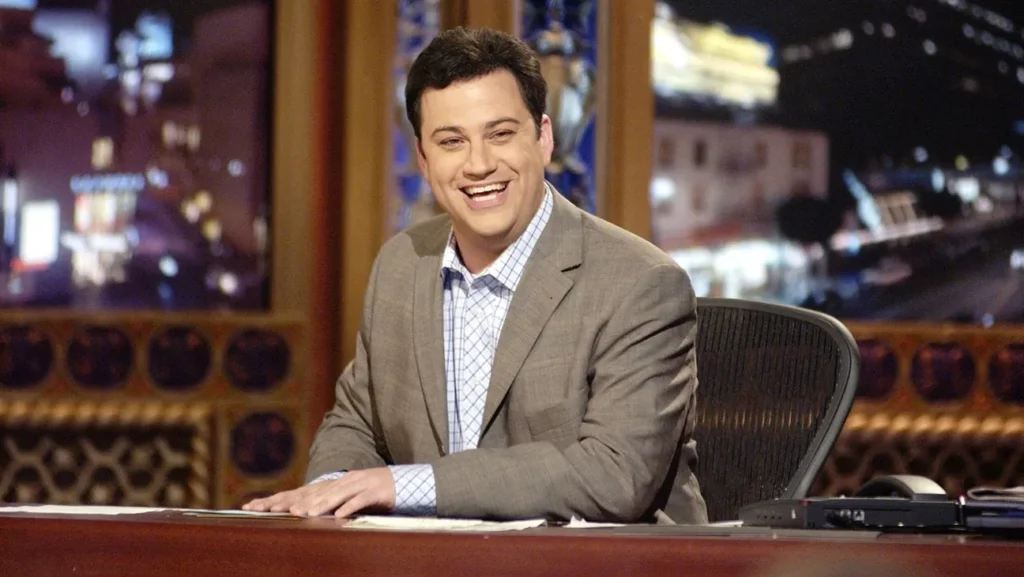When Jimmy Kimmel walks onto his late-night stage, he doesn’t look like a polished network host. He looks like a guy who could be sitting next to you in the kitchen, telling funny stories about life. He’s not afraid to be goofy, awkward, or overly emotional – and that’s exactly why he became the face of a new media age: the age of YouTube, where honesty matters more than polish.
Television That Feels Personal
When Jimmy Kimmel Live! first aired, TV and the internet were like neighbors who refused to say hello. Television was “high art.” YouTube – launched two years later – was a playground for college kids. But Kimmel saw what others didn’t: the future. He never tried to act like a “serious host.” Instead, he built a show that felt like a conversation among friends.

He understood one simple truth before anyone else did: people don’t need an hour-long show – they need moments. Funny, sharp, real moments. That’s how his short segments were born – bite-sized bits made to be clipped, shared, and replayed. Within a couple of years, Kimmel’s sketches were being quoted, remixed, and parodied across the globe.
The King of Unexpected Pranks
“I Told My Kids I Ate All Their Halloween Candy.” Those words are now legendary. Every year after Halloween, parents would film their kids’ reactions to discovering their candy was gone. Some burst into tears, others shrugged philosophically, and a few started mini-revolutions. It was pure human emotion – YouTube gold.
And then came Mean Tweets, where celebrities read nasty posts about themselves, either deadpan or laughing through the pain. The format was so simple it’s hard to believe no one thought of it earlier. Perfect timing, raw emotion, short and snappy – the holy trinity of viral content.
Kimmel seemed to sense what the industry hadn’t yet grasped: television no longer belonged to the networks. It belonged to the audience – people ready to grab a snippet, repost it, and make it part of internet culture.
When a Show Takes on a Life of Its Own
As Zoomboola notes, Jimmy Kimmel was one of the first to create television moments that worked perfectly online. Remember the viral clip from 2013 where a girl accidentally sets herself on fire while dancing? Millions of views, global headlines – and then Kimmel revealed live on air that it was a staged prank with a stunt performer. The internet went wild.
He blurred the line between truth and fiction, between broadcast TV and viral hoax. Every bit of his show could live independently, far beyond the timeslot. Kimmel’s rule is simple: anything longer than three minutes risks getting skipped. So his team keeps it fast, focused, and alive – monologues, pranks, street interviews, surprise musical bits – all tailor-made for YouTube, TikTok, or whatever platform rules the moment.
Each segment is a self-contained story. No context needed, no buildup required. You press play, get the emotion, and move on. That’s why millions who’ve never watched Jimmy Kimmel Live! on TV still know him as “that guy from YouTube.”
So What’s His Secret?
Kimmel never talks down to his audience. He jokes about what everyone’s thinking – prices, politics, family chaos, celebrity weirdness. Sometimes he crosses the line, sometimes he stumbles, but he never hides behind the screen. If he messes up, he owns it. If a joke bombs, he laughs along.
Jimmy Kimmel became the bridge between two worlds – the old and the new. He grew up in television but thinks like a creator. He respects the format yet isn’t afraid to poke fun at it. His humor feels human: a little rough, a little tender, always real.
He didn’t bring YouTube to television – he made television feel like YouTube. And maybe that’s why his clips outlive the broadcast, and his jokes become part of internet history.